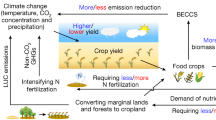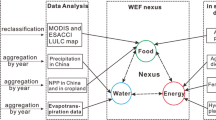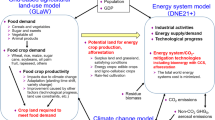Abstract
Negative emission technologies such as bioenergy with carbon capture and storage (BECCS) are regarded as an option to achieve the climatic target of the Paris Agreement. However, our understanding of the realistic sustainable feasibility of the global lands for BECCS remains uncertain. In this study, we assess the impact of BECCS deployment scenarios on the land systems including land use, water resources, and ecosystem services. Specifically, we assess three land-use scenarios to achieve the total amount of 3.3 GtC year−1 (annual negative emission level required for IPCC-RCP 2.6) emission reduction by growing bioenergy crops which requires huge use of global agricultural and forest lands and water. Our study shows that (1) vast conversion of food cropland into rainfed bio-crop cultivation yields a considerable loss of food production that may not be tolerable considering the population increase in the future. (2) When irrigation is applied to bio-crop production, the bioenergy crop productivity is enhanced. This suppresses the necessary area for bio-crop production to half, and saves the land for agricultural productions. However, water consumption is doubled and this may exacerbate global water stress. (3) If conversion of forest land for bioenergy crop cultivation is allowed without protecting the natural forests, large areas of tropical forest could be used for bioenergy crop production. Forest biomass and soil carbon stocks are reduced, implying degradation of the climate regulation and other ecosystem services. These results suggest that without a careful consideration of the land use for bioenergy crop production, a large-scale implementation of BECCS could negatively impact food, water and ecosystem services that are supporting fundamental human sustainability.








Similar content being viewed by others
References
Arnold JG, Kiniry JR, Srinivasan R, Williams JR, Haney EB, Neitsch SL (2012) SWAT Input/Output Documentation Version 2012, Texas Water Resources Institute, p 654
Bengtsson M, Shen Y, Oki T (2006) A SRES-based gridded global population dataset for1990–2100. Popul Environ 28:113–131
Betts RA (2011) Afforestation cools more or less. Nat Geosci 4:504–505
Bonsch M, Humpenöder F, Popp A, Bodirsky B, Dietrich JP, Rolinski S, Biewald A, Lotze-Campen H, Weindl I, Gerten D, Stevanovic M (2016) Trade-offs between land and water requirements for large-scale bioenergy production. GCB Bioenergy 8:11–24. https://doi.org/10.1111/gcbb.12226
Chini LP, Hurtt GC, Frolking S (2014) Harmonized global land use for years 1500–2100, V1. Oak Ridge National Laboratory Distributed Active Archive Center, Oak Ridge. https://doi.org/10.3334/ORNLDAAC/1248
Creutzig F, Agoston P, Minx JX, Canadell JG, Andrew RM, Quéré C, Peters GP, Sharifi A, Yamagata Y, Dhakal S (2016) Urban infrastructure choices structure climate solutions. Nat Clim Change 6:1054–1056
Döll P, Hoffmann-Dobrev H, Portmann FT, Siebert S, Eicker A, Rodell M, Strassberg G, Scanlon BR (2012) Impact of water withdrawals from groundwater and surface water on continental water storage variations. J Geodyn 59/60:143–156. https://doi.org/10.1016/j.jog.2011.05.001
Fujimori S, Masui T, Matsuoka Y (2014) Development of a global computable general equilibrium model coupled with detailed energy end-use technology. Appl Energy 128:296–306
Fuss S, Canadell JG, Peters GP, Tavoni M, Andrew RM, Ciais P, Jackson RB, Jones CD, Kraxner F, Nakicenovic N, Le Quéré C, Raupach MR, Sharifi A, Smith P, Yamagata Y (2014) Betting on negative emission. Nat Clim Change 4:850–853
Gaffin SR, Rosenzweig C, Xing X, Yetman G (2004) Downscaling and geo-spatial gridding of socio-economic projections from the IPCC special report one missions scenarios (SRES). Glob Environ Change 14:105–123
Grübler A, O’Neill B, Riahi K, Chirkov V, Goujon A, Kolp P, Prommer I, Scherbov S, Slentoe E (2007) Regional, national, and spatially explicit scenarios of demographic and economic change based on SRES. Technol Forecast Soc 74:980–1029
Hachadoorian L, Gaffin S, Engelman R (2011) Projecting a gridded population of the world using ratio methods of trend extrapolation. In: Cincotta R, Gorenflo L (eds) Human population. Springer, New York, pp 13–25
Hanasaki N, Kanae S, Oki T, Masuda K, Motoya K, Shirakawa N, Shen Y, Tanaka K (2008a) An integrated model for the assessment of global water resources—Part 1: model description and input meteorological forcing. Hydrol Earth Syst Sci 12:1007–1025. https://doi.org/10.5194/hess-12-1007-2008
Hanasaki N, Kanae S, Oki T, Masuda K, Motoya K, Shirakawa N, Shen Y, Tanaka K (2008b) An integrated model for the assessment of global water resources—Part 2: applications and assessments. Hydrol Earth Syst Sci 12:1027–1037. https://doi.org/10.5194/hess-12-1027-2008
Hanasaki N, Fujimori S, Yamamoto T, Yoshikawa S, Masaki Y, Hijioka Y, Kainuma M, Kanamori Y, Masui T, Takahashi K, Kanae S (2013a) A global water scarcity assessment under Shared Socio-economic Pathways – Part 1: Water use. Hydrology and Earth System Sciences 17(7):2375–2391
Hanasaki N, Fujimori S, Yamamoto T, Yoshikawa S, Masaki Y, Hijioka Y, Kainuma M, Kanamori Y, Masui T, Takahashi K, Kanae S (2013b) A global water scarcity assessment under Shared Socio-economic Pathways – Part 2: Water availability and scarcity. Hydrology and Earth System Sciences 17(7):2393–2413
Hanasaki N, Inuzuka T, Kanae S, Oki T (2010) An estimation of global virtual water flow and sources of water withdrawal for major crops and livestock products using a global hydrological model. J Hydrol 384:232–244. https://doi.org/10.1016/j.jhydrol.2009.09.028
Hanasaki N, Yoshikawa S, Pokhrel Y, Kanae S (2017) A global hydrological simulation to specify the sources of water used by humans. Hydrol Earth Syst Sci Discuss 2017:1–53. https://doi.org/10.5194/hess-2017-280
Hejazi MI, Voisin N, Liu L, Bramer LM, Fortin DC, Hathaway JE, Huang M, Kyle P, Leung LR, Li H-Y, Liu Y, Patel PL, Pulsipher TC, Rice JS, Tesfa TK, Vernon CR, Zhou Y (2015) 21st century United States emissions mitigation could increase water stress more than the climate change it is mitigating. Proc Natl Acad Sci USA 112:10635–10640. https://doi.org/10.1073/pnas.1421675112
Hempel S, Frieler K, Warszawski L, Schewe J, Piontek F (2013) A trend-preserving bias correction—the ISI-MIP approach. Earth Syst Dyn 4:219–236. https://doi.org/10.5194/esd-4-219-2013
Ito A (2007) Simulated impacts of climate and land-cover change on soil erosion and implication for the carbon cycle, 1901 to 2100. Geophys Res Lett 34:L09403. https://doi.org/10.1029/2007GL029342
Ito A, Inatomi M (2012) Water-use efficiency of the terrestrial biosphere: a model analysis on interactions between the global carbon and water cycles. J Hydrometeorol 13:681–694. https://doi.org/10.1175/JHM-D-10-05034.1
Ito A, Oikawa T (2002) A simulation model of the carbon cycle in land ecosystems (Sim-CYCLE): a description based on dry-matter production theory and plot-scale validation. Ecol Model 151:147–179
Jones B, O’Neill BC (2016) Spatially explicit global population scenarios consistent with the shared socioeconomic pathways. Environ Res Lett 11:084003
Kato E, Yamagata Y (2014) BECCS capability of dedicated bioenergy crops under a future land-use scenario targeting net negative carbon emissions. Earth’s Future 2:421–439. https://doi.org/10.1002/2014EF000249
Kato E, Kinoshita T, Ito A, Kawamiya M, Yamagata Y (2013) Evaluation of spatially explicit emission scenario of land-use change and biomass burning using a process based biogeochemical model. J Land Use Sci 8:104–122
Le Quéré C, Andrew RM, Canadell JG, Sitch S, Korsbakken JI, Peters GP, Manning AC, Boden TA, Tans PP, Houghton RA, Keeling RF, Alin S, Andrews OD, Anthoni P, Barbero L, Bopp L, Chevallier F, Chini LP, Ciais P, Currie K, Delire C, Doney SC, Friedlingstein P, Gkritzalis T, Harris I, Hauck J, Haverd V, Hoppema M, Klein Goldewijk K, Jain AK, Kato E, Körtzinger A, Landschützer P, Lefèvre N, Lenton A, Lienert S, Lombrardozzi D, Melton JR, Metzl N, Millero F, Monteiro PMS, Munro DR, Nabel JEMS., Nakaoka S, O’Brien K, Olsen A, Omar AM, Ono T, Pierrot D, Poulter B, Rödenbeck C, Salisbury J, Schuster U, Schwinger J, Séférian R, Skjelvan I, Stocker BD, Sutton AJ, Takahashi T, Tian H, Tilbrook B,, Viovy N, Walker AP, Wiltshire AJ, Zaehle S, van der Laan-Luijkx IT, van der Werf GR (2016) Global carbon budget 2016. Earth Syst Sci Data 8:605–649. https://doi.org/10.5194/essd-8-605-2016
McKee JJ, Rose AN, Bright EA, Huynh T, Bhaduri BL (2015) Locally adaptive, spatially explicit projection of US population for 2030 and 2050. Proc Natl Acad Sci 112:1344–1349
Melillo JM, Reilly JM, Kicklighter DW, Gurgel AC, Cronin TW, Paltsev S, Felzer BS, Wang X, Sokolov AP, Schlosser CA (2009) Indirect emissions from biofuels: how important? Science 326:1397–1399. https://doi.org/10.1126/science.1180251
Misztal PK, Nemitz E, Langford B, Di Marco CF, Phillips GJ, Hewitt CN, MacKenzie AR, Owen SM, Fowler D, Heal MR, Cape JN (2011) Direct ecosystem fluxes of volatile organic compounds from oil palms in South-East Asia. Atm Chem Phys 11:8995–9017. https://doi.org/10.5194/acp-11-8995-2011
Monfreda C, Ramankutty N, Foley JA (2008) Farming the planet: 2. Geographic distribution of crop areas, yields, physiological types, and net primary production in the year 2000. Glob Biogeochem Cycles 22:GB1022. https://doi.org/10.1029/2007GB002947
Murakami D, Yamagata Y (2016) Estimation of gridded population and GDP scenarios with spatially explicit statistical downscaling. arXiv:1610.09041
Myers N, Mittermeier RA, Mittermeier CG, da Fanseca GAB, Kent J (2000) Biodiversity hotspots for conservation priorities. Nature 403:853–858
Nam K-M, Reilly JM (2013) City size distribution as a function of socioeconomic conditions: an eclectic approach to downscaling global population. Urban Stud 50:208–225
Newbold T, Hudson LN, Arnell AP, Contu S, De Palma A, Ferrier S, Hill SLL, Hoskins AJ, Lysenko I, Phillips HRP, Burton VJ, Chng CWT, Emerson S, Gao D, Pask-Hale G, Hutton J, Jung M, Sanchez-Ortiz K, Simmonds BI, Whitmee S, Zhang H, Scharlemann JPW, Purvis A (2016) Has land use pushed terrestrial biodiversity beyond the planetary boundary? A global assessment. Science 353:288–291. https://doi.org/10.1126/science.aaf2201
Riahi K, Van Vuuren DP, Kriegler E, Edmonds J, O’neill BC, Fujimori S, Bauer N, Calvin K, Dellink R, Fricko O, Lutz W, Popp A, Cuaresma JC, Samir KC, Leimbach M, Jiang L, Kram T, Rao S, Emmerling J, Ebi K, Hasegawa T, Havlik P, Humpenoder F, Da Silva LA, Smith S, Stehfest E, Bosetti V, Eom J, Gernaat D, Masui T, Rogeli J, Strefler J, Drouet L, Krey V, Luderer G, Harmsen M, Takahashi K, Baumstark L, Doelman JC, Kainuma M, Kilmont Z, Marangoni G, Lotze-Campen H, Obersteiner M, Tabeau A, Tavoni M (2017) The shared socioeconomic pathways and their energy, land use, and greenhouse gas emissions implications: an overview. Glob Environ Change 42:153–168. https://doi.org/10.1016/j.gloenvcha.2016.05.009
Schellnhuber HJ, Rahmstorf S, Winkelmann R (2016) Why the right climate target was agreed in Paris. Nat Clim Change 6:649–653. https://doi.org/10.1038/nclimate3013
Schleussner CF, Lissner TK, Fischer EM, Wohland J, Perrette M, Golly A, Rogelj J, Childers K, Schewe J, Frieler K, Mengel M, Hare W, Schaeffer M (2016) Differential climate impacts for policy-relevant limits to global warming: the case of 1.5 °C and 2 °C. Earth Syst Dyn 7:327–351. https://doi.org/10.5194/esd-7-327-2016
Siebert S, Döll P, Hoogeveen J, Faures JM, Frenken K, Feick S (2005) Development and validation of the global map of irrigation areas. Hydrol Earth Syst Sci 9:535–547. https://doi.org/10.5194/hess-9-535-2005
Smith P, Davis SJ, Creutzig F, Fuss S, Minx J, Gabrielle B, Kato E, Jackson RB, Cowie A, Kriegler E, van Vuuren DP, Rogelj J, Ciais P, Milne J, Canadell JG, McCollum D, Peters G, Andrew R, Krey V, Shrestha G, Friedlingstein P, Gasser T, Grübler A, Heidug WK, Jonas M, Jones CD, Kraxner F, Littleton E, Lowe J, Moreira JR, Nakicenovic N, Obersteiner M, Patwardhan A, Rogner M, Rubin E, Sharifi A, Torvanger A, Yamagata Y, Edmonds J, Yongsung C (2016) Biophysical and economic limits to negative CO2 emissions. Nat Clim Change 6:42–50. https://doi.org/10.1038/NCLIMATE2870
van Vuuren DP, Lucas PL, Hilderink H (2007) Downscaling drivers of global environmental change. Glob Environ Change 17:114–130
van Vuuren DP, Edmonds J, Kainuma M, Riahi K, Thomson A, Hibbard K, Hurtt GC, Kram T, Krey V, Lamarque J-F, Masui T, Meinshausen M, Nakicenovic N, Smith SJ, Rose SK (2011) The representation concentration pathways: an overview. Clim Change 109:5–31. https://doi.org/10.1007/s10584-011-0148-z
Watanabe S, Hajima T, Sudo K, Nagashima T, Takemura T, Okajima H, Nozawa T, Kawase H, Abe M, Yokohata T, Ise T, Sato H, Kato E, Takata K, Emori S, Kawamiya M (2011) MIROC-ESM 2010: model description and basic results of CMIP5-20c3m experiments. Geoscientific Model Development 4(4):845–872
Yamagata Y, Murakami D, Seya H (2015) A comparison of grid-level residential electricity demand scenarios in Japan for 2050. Appl Energy 158:255–262
Acknowledgements
This study was supported by the Environment Research and Technology Development Fund (S-10: Integrated Climate Assessment—Risks, Uncertainties and Society) of the Ministry of the Environment, Japan. Q.Z. was supported by the Environment Research and Technology Development Fund (S-14) of the Ministry of the Environment, Japan. This work is a collaborative effort under the MaGNET (Managing Global Negative Emissions Technologies) initiative of the Global Carbon Project (http://www.cger.nies.go.jp/gcp/magnet.html), a core project of Future Earth.
Author information
Authors and Affiliations
Corresponding author
Additional information
Handled by Kiyoshi Takahashi, Kokuritsu Kankyo Kenkyujo Shakai Kankyo Shisutemu Kenkyu Sentaa, Japan.
Rights and permissions
About this article
Cite this article
Yamagata, Y., Hanasaki, N., Ito, A. et al. Estimating water–food–ecosystem trade-offs for the global negative emission scenario (IPCC-RCP2.6). Sustain Sci 13, 301–313 (2018). https://doi.org/10.1007/s11625-017-0522-5
Received:
Accepted:
Published:
Issue Date:
DOI: https://doi.org/10.1007/s11625-017-0522-5




